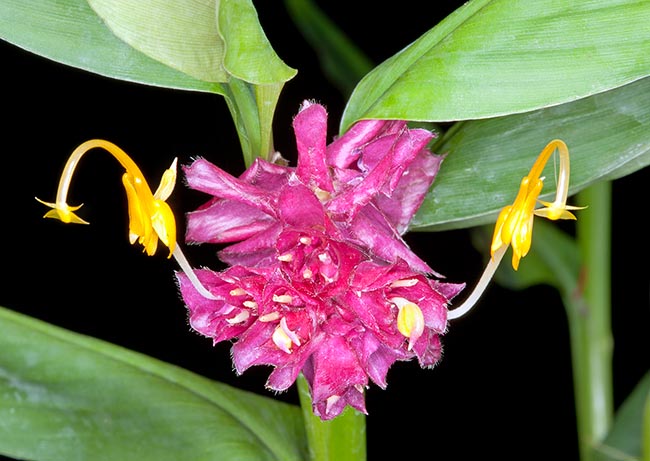Family : Zingiberaceae

Text © Pietro Puccio

English translation by Mario Beltramini

Globba globulifera is at home in Thailand and Vietnam where grows in the humid forests © Giuseppe Mazza
The species is native to Thailand and Vietnam where it grows in the undergrowth of the humid forests.
The name of the genus comes from the local name “galoba” used in the island of Ambon (Indonesia) for indicating various Zingiberaceae; the name of the species is the combination of the Latin substantive “globulus” = small sphere and of the verb “fero” = to carry, with reference to the globose bulbils forming at the axil of the bracts of the inflorescence.
Common names: purple globe ginger (English).
The Globba globulifera Gagnep. (1901) is a deciduous perennial rhizomatous herbaceous species, 30-60 cm tall, with creeping rhizome, a pseudo-stem formed by the sheathed foliar bases and lanceolate subsessile leaves with pointed apex, 20 cm long and 3 cm broad. Hanging, panicle, terminal inflorescence, compact, globose, about 5 cm long, with flowers subtended by ovate purple pink imbricate bracts 1 cm long and 0,7-1 cm broad. The flowers are yellow with trilobed tubular calyx with pointed lobes, tubular corolla with concave lobes, lanceolate lateral staminodes, biparted labellum, stamen with a long curved filament and anther with 4 pointed wings. At the axil of the bracts it produces verrucose globose “bulbils”. The fruits are globose capsules containing small seeds equipped with aril (fleshy tissue partially enveloping the seed) of white colour.
It reproduces by seed in loam rich of organic substance with addition of sand or perlite per a 30%, maintained humid at the temperature of 22-24 °C, by division and easily through the bulbils.
Small species cultivable in humid tropical and subtropical climate zones, in semi-shaded to shaded position, on perfectly draining soils rich of humus, slightly acidic to neutral, maintained constantly humid but without stagnations, during the vegetative period; at rhizome level, during the resting time, can resist to temperatures even of some degree under the 0 °C only if maintained dry. In the cold climates the rhizomes can be interred in spring, with blooming in late summer, and extracted in autumn and conserved in cool and dry location. It well adapts to the cultivation in pot utilizing an organic loam with addition of sand or agri-perlite per a 30%, the watering must be regular and abundant in summer, stopped in winter during the resting period and the pot to be placed in dry location with temperature preferably not under the 10 °C.
The cut inflorescences, long-lasting, are particularly appreciated in the floral compositions.
